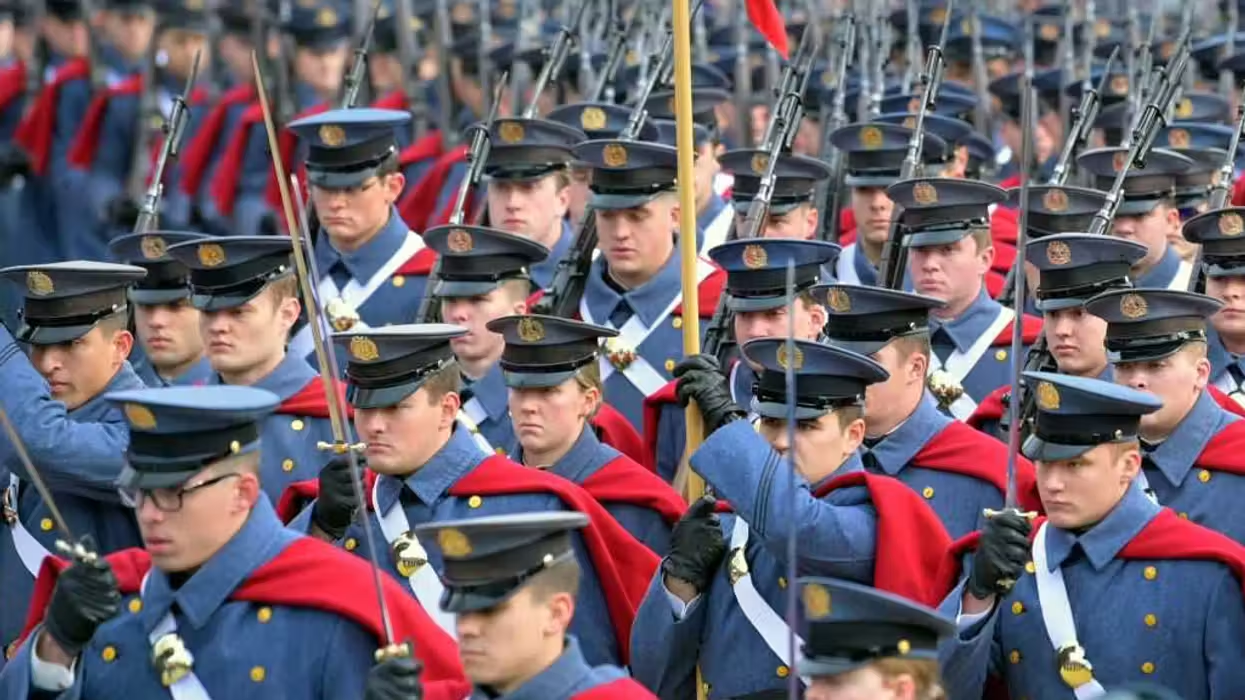
Photo by John McDonnell/Washington Post via Getty Images

The declining state of American boys and the immiseration of girls makes it increasingly necessary.
Sex-specific education is essential to preserve America’s self-governing republic. Though many are only now rediscovering single-sex public schooling, there is still space for it to exist within the framework established by the Supreme Court’s 1996 United States v. Virginia decision, as I argue in a just-released “Provocation” for the Claremont Institute’s Center for the American Way of Life. In that decision, Justice Ruth Bader Ginsburg ruled for the 7-1 majority that the Virginia Military Institute, a public school, must admit women.
The Bush administration sued VMI in the early 1990s, alleging that Virginia’s single-sex military school violated the 14th Amendment’s Equal Protection Clause. The Clinton administration continued the case, and Virginia had to tailor its defense to the reigning civil rights framework. Since VMI’s discriminatory practices faced “intermediate scrutiny” from the courts, Virginia had to prove that its admissions policies supported practices that served important but gender-neutral educational goals.
VMI’s once-famous standards have been eroded, its core values replaced with bureaucratic boilerplate, and its culture hobbled by the artificial imposition of modern sensitivities.
Virginia asserted that men especially benefit from and are attracted to VMI's distinctives, including its Marine-style, in-your-face “adversative” training methods, its lack of privacy, its egalitarian grooming and uniform standards, and its rigorous, stoical honor code.
After proving that its admissions policy matched its practices, Virginia had to prove that the purposes served by the adversative method were legitimate. Under our reigning civil rights ideology, however, VMI had to fight with its strongest hand tied behind its back.
VMI’s defenders could discuss only gender-neutral goals, such as increasing test scores, educational excellence, or maintaining institutional diversity. They could not mention the real reason VMI existed: to point men to a special destiny grounded in manly honor, martial valor, and public-spirited ambition.
Still, VMI prevailed in the lower courts, as the school fostered the diversity of educational offerings in Virginia and elevated the test scores of the men who attended. VMI would, as lower courts held, be “significantly different upon the admission of women,” and the school “would eventually find it necessary to drop the adversative system altogether.”
The Clinton administration appealed the case to the Supreme Court and won.
Ginsburg’s decision, from which only Justice Antonin Scalia dissented (Justice Clarence Thomas recused himself, as his son was enrolled at VMI at the time), now sets the boundaries for sex discrimination cases generally and for single-sex schooling in particular. According to Ginsburg, keeping women away from VMI’s distinctive education could be justified only by outmoded stereotypes about how women are demure, uncompetitive, and domestic.
The notion that admission of women would … destroy the adversative system and, with it, even the school, is a judgment hardly proved, a prediction hardly different from other ‘self-fulfilling prophec[ies]’ once routinely used to deny rights or opportunities. … Women’s successful entry into the military academies, their participation in the Nation’s military forces, indicate that Virginia’s fears for the future of VMI may not be solidly grounded.
All the expert testimony in the world would not shake Ginsburg’s belief that sex differences were culturally contrived, so policies based on claims about sex differences are, on this view, simply stereotypes. Surely American women would adopt the fierce attitudes of Viking shield-maidens (as they appear on television, at least) if given the chance.
“Virginia’s fears for the future of VMI” were indeed very well grounded. Using only publicly available information, my report charts how VMI is no longer what it once was. The school’s once-famous standards have been eroded, its core values replaced with bureaucratic boilerplate, its connections to tradition and the past broken, and its culture hobbled by the artificial imposition of modern sensitivities.
In principle, the Virginia Military Institute could keep the same admission standards and adversative training methods while admitting only women — perhaps just a few each year — who can meet them.
Josiah Bunting III, VMI’s president during U.S. v. Virginia, said, “Female cadets will be treated precisely as we treat male cadets. I believe fully qualified women would themselves feel demeaned by any relaxation in the standards the VMI system imposes on young men.”
Every cadet would get the same buzz cut. Every cadet would have to meet the same mile time. Every cadet would be treated the same — like dirt.
In reality, though, the logic of civil rights law would never allow VMI to admit only a tiny minority of women. Instead, future litigation would likely take low female admission rates as evidence that the standards themselves were forms of covert discrimination.
Predictably, VMI changed to pre-empt future legal action.
By the early 2000s, standards had been relaxed across the board to make physical benchmarks more accessible for women to achieve. Male cadets now must perform a minimum of five pull-ups, while one is sufficient for females. Male cadets must run 1.5 miles in 12 minutes, 30 seconds, while females get almost an additional two minutes. In 2001, female cadets were allowed to eschew buzz cuts for more feminine hairstyles. Current hair standards permit females to wear their hair down to their shoulder blades.
VMI’s experience after integration raises a deeper question: Is separation of the sexes healthy only when sanitized, or can it serve the natural differences between men and women?
Most illuminating is the change in VMI’s “Code of a Gentleman,” which was replaced by the “Code of a Cadet” in the early 2000s. In 2022, the school implemented an even more “inclusive” code.
The old code was stoical, demanded silence on private matters (finances, girlfriends), taught sturdy independence within a hierarchy (a gentleman “does not lick the books of those above” nor “kick the face of those below him”), and instilled self-control in matters relating to drink, gambling, and other vices.
VMI contributed to a military tradition dating back centuries, eschewing fads and embracing the Western and Christian traditions. A VMI gentleman was “the descendant of the knight, the crusader … the defender of the defenseless and the champion of justice.”
In contrast, under the new code, a cadet aspired to be a social worker, standing “against intolerance, prejudice, discrimination, hate, and oppression.” Nothing situates the cadet in the Western tradition, nor is anything said about justice or any intimation of self-sacrifice or courage. Instead, the new code ends with vague platitudes about ill-defined trendy terms.
A VMI cadet is a well-mannered, respectful, and properly presented individual who holds themself and others accountable for their actions and words as a valued member of the Corps. VMI standards are high for a meaningful purpose — to produce leaders of character. A cadet wears the VMI uniform with pride, always remembering and demonstrating what it means to be a VMI cadet.
The old ethos was republican. The new one is managerial. Students wrote the old code and handed it down by tradition, but it was not formalized or blessed by the administration. Officially, no one had to memorize it. Peers enforced the rules through mentoring and discipline.
Meanwhile, the Code of the Cadet is formal (written by the administration), and cadets must memorize it. The commandant’s office oversees training in the code and punishes violations in consultation with the school’s Diversity and Inclusion Office.
What was once in the hands of the cadets is now in the hands of the administration and managers. Informal oversight has disappeared in favor of formal, legalistic, and administrative demands since the student culture, allegedly a product of racism and sexism, cannot be trusted to take the lead. The diversity, equity, and inclusion revolution of the past 15 years, along with the post-George Floyd fever, has brought further changes.
Even a cursory survey of VMI’s history after U.S. v. Virginia puts the lie to Justice Ginsburg’s blithe insistence that the institution could remain substantially unchanged after the admission of women.
RELATED: Feminism weakened our military — now it’s time to fix the damage

Ginsburg left escape hatches for single-sex education, which she thought must not be based on outmoded stereotypes about how men and women are different or their various social destinies. Single-sex must be completely voluntary. The institutions must also be genuinely equal, yet sex-specific.
The experience of VMI after sexual integration raises a deeper question that is obscured by our reigning civil rights ideology: Is the separation of the sexes healthy only when it serves some inoffensive gender-neutral purpose? Or can it be wholesome per se, serving the innate differences between men and women and their somewhat different social destinies?
In order to test U.S. v. Virginia and force the courts to answer this question, a state should establish a VMI-type academy. Under those circumstances, the case against U.S. v. Virginia should not only reassert the record of sex differences since the original case was decided, but also show how the idea of manly honor has been deconstructed at VMI since its sexual integration, defend the public utility of manly honor specifically, and argue (within reason) for distinct sex roles as a positive good.
In its heyday, the Virginia Military Institute stood within a broader social order of single-sex schools and clubs that trained young men and women for distinct but complementary roles. As public approval for such differences waned and policy flattened them into sameness, the institutions that once shaped boys into men and girls into women faded away.
That private system once thrived — and it served the nation’s men and women well. It could do so again.
Today, it would be a radical departure from our co-ed present to create a voluntary track within the public school system for serious sex-specific education. School choice movements make such an option possible, and the declining state of boys and the immiseration of American girls make it more and more necessary.
Editor’s note: A version of this article was published originally at the American Mind.
Scott Yenor